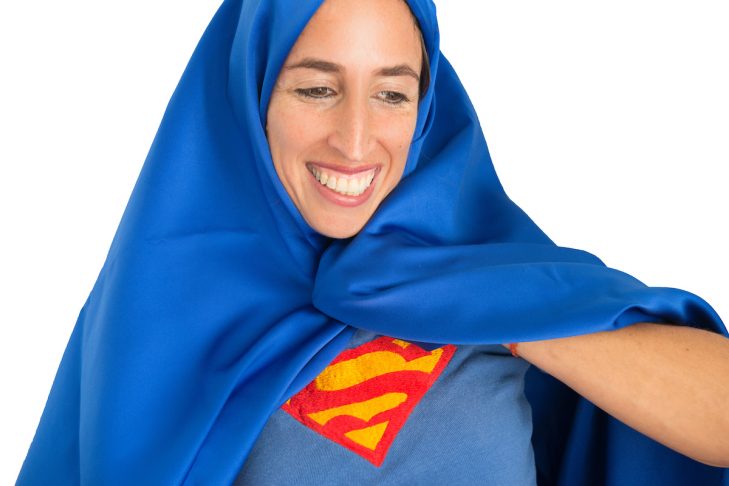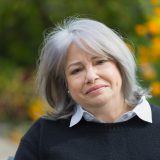The most powerful words you can say to another person are, “Tell me your story.” Public artist Julia Vogl experienced this firsthand when she asked 1,800 people across the Boston area last month questions about what freedom means to them. Stories came tumbling out, and of the 103 she recorded, 44 audio stories—personal reflections on experiencing freedom and immigrating to America—are now available on the Jewish Arts Collaborative website as part of the “Pathways to Freedom” public art project. As Vogl recently told JewishBoston, “The entire project is contingent upon people sharing their life stories. I set up a premise and people have engaged with it.”
The next step in Vogl’s “Pathways to Freedom” project is now installed on the Boston Common. The resulting mural is made up of larger reproductions of the patterned, color-coded pins—pins Vogl created based on participants’ answers to four questions about freedom. People walked away with their individualized pins and some were spotted around town wearing them. Vogl and the cart where she made the pins were at various locations across the Boston area, including Boston’s City Hall, a town meeting in Dorchester and the JCC Greater Boston in Newton. The goal was to explore the conditions in which people feel free and the obstacles that can hinder freedom.
Vogl’s multi-color mural is also intended to be a space in which dialogue and contemplation are encouraged. “I knew the cart experience was going to be different than being here,” Vogl said on site at the installation. “But it’s incredible to have people come back and find their buttons reproduced on the mural. This project is about empowering individuals and diverse narratives that make up Boston here and now.”
Vogl added: “The whole process of creating this project has been transparent. People who participated knew it was going to be on the Boston Common and had some idea of what it was going to look like. All in all, people trusted us to do justice to their stories.”

Photographer Brenda Bancel has also been entrusted with people’s stories. Her new show, “Holding Differences Tenderly,” is on display at the Vilna Shul through May 25. The photographs represent different areas of Bancel’s life. A student at Harvard Divinity School, Bancel recalled that at orientation one of the school chaplains said, “We are here to dilute misery in the world.” Bancel takes that approach in her role as a teacher and photographer. She teaches photography at the Epiphany School in Dorchester in the “Take 5” program. Bancel mentors five middle-school age students and boosts their confidence by teaching them to take great photographs.
The exhibit features pictures of one of her students, Roody Jean Louis, who is photographed wearing his hoodie in different ways. “Roody was told not to wear his hoodie in school, but he says that his hoodie is his house,” Bancel said. “He’s very shy and doesn’t want to come out of it. It all helps him looking tough in his neighborhood. It’s armor. The photographs of him wearing the hoodie are representations of who he is under that hoodie.”
Bancel said the goal of the show is to “disrupt assumptions” about who people are. Two photographs in the exhibit upend stereotypes by superimposing words that allude to “a spectrum of who we are. In America, many of us assume a woman in a veil or hijab is submissive or a terrorist. But the Virgin Mary is always depicted as covered, so that’s why I also have the words “Virgin Blessed Mother” projected on a picture of a woman wearing a hijab. I also have projected words that include terrorist, submissive, feminist and mother.”
Bancel’s fascination with women unveiling and veiling was part of a project she did at Harvard Divinity School. It also brought her to the Vilna Shul in her Beacon Hill neighborhood. Lynn Krasker Schulz, Vilna Shul’s director of development, said Bancel originally approached her to find Jewish women who cover their hair and would be willing to be photographed. “Jewish women were not talking to her,” Krasker Schulz told JewishBoston. “But Muslim women were. That’s how we got to know Brenda.”
Bancel said some of her photographs are meant to “rebrand the veil or hijab. I met this woman who said she had a superwoman hijab and I took her photograph.” Another picture depicts a Harvard student wearing an array of colorful hijabs. “She was excited to pose for the photograph as a model representing gay sexuality, as well as also being a practicing Islamic woman,” she said.
All of Bancel’s photographs for the exhibit are mounted against red, white or blue curtains, giving it a Fourth of July feeling. “If we really want to get along,” she said, “we have to know how we’re different. We need to hold our differences tenderly. We’re not homogeneous. Our new America is starting to look different. Let’s embrace that.”



